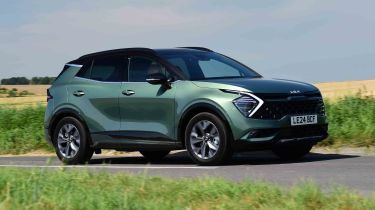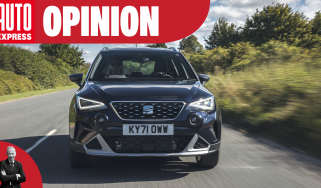Kia Sportage - MPG, CO2 and running costs
The low running costs of the hybrid models make them the pick of the Sportage range over the petrol version

You can get your Kia Sportage in mild-hybrid petrol, full-hybrid, and plug-in hybrid forms, giving everyone from family buyers to business users and everyone else in between a Sportage to suit their driving needs.
The 157bhp 1.6 T-GDi petrol returns up to 43.5mpg on the WLTP combined cycle. Although these figures seem reasonable in isolation, they can’t compete with the more economical full-hybrid and plug-in hybrid variants. It’s worth bearing in mind that improved overall efficiency comes at a price, and the cheapest PHEV model – in GT-Line trim – is significantly more expensive to buy than the equivalent petrol model.
The full-hybrid starts from around £36,000 in GT-Line trim and, depending on specification, manages up to 49.6mpg and 128g/km of CO2.
| Model | MPG | CO2 | Insurance group |
| Sportage 1.6 T-GDi 2 | 43.5mpg | 147g/km | 19E |
| Sportage 1.6 HEV 2WD GT-Line | 49.6mpg | 128g/km | 22E |
| Sportage 1.6 HEV 4WD GT-Line S | 44.1mpg | 146g/km | 24E |
Electric range, battery life and charge time
Thanks to its 13.8kWh battery, the plug-in hybrid Sportage has an electric range of up to 42 miles. Recharging the battery from flat to 100 per cent at home using a 7.4kW wall box charger takes around two hours. The battery is covered by a separate warranty that guarantees it will maintain above 70 per cent capacity over seven years or 100,000 miles, whichever comes first.
| Model | Battery size | Range | Insurance group |
| Sportage 1.6 PHEV GT-Line AWD | 13.8kWh | 42 miles | 26E |
Tax
Company car drivers will find the plug-in hybrid the most appealing due to its low Benefit-in-Kind (BiK) tax rate — although an electric car will be lower still. Its CO2 emissions are 25g/km, allowing this version to fall into the eight per cent BiK bracket (for the 24/25 tax year, nine per cent for 25/26).
Used - available now

2021 KIA
Sportage
19,786 milesAutomaticDiesel1.6L
Cash £22,099
2023 KIA
Sportage
14,662 milesAutomaticPetrol1.6L
Cash £23,500
2023 KIA
Sportage
22,476 milesManualPetrol1.6L
Cash £19,300
2021 KIA
Sportage
18,918 milesManualPetrol1.6L
Cash £15,800The mild-hybrid and full-hybrid versions will be more costly for company car drivers. The 157bhp 1.6 T-GDi emits 146g/km and falls into the 34 per cent bracket, while the hybrid 1.6 HEV emits 129g/km and is in the 30 per cent band.
For private buyers, most of the Sportage petrol and hybrid range (except for the GT-Line S hybrid and GT-Line S AWD versions) avoid the surcharge for cars costing more than £40,000 when new. Unfortunately, none of the plug-in hybrid PHEV models do, so they will cost significantly more to tax from the second year of registration until the car is six years old.
Insurance groups
Insurance premiums for the Sportage shouldn’t be too expensive. Entry-level petrol-powered Sportages in ‘2’ trim starts in insurance group 19 out of 50, while the range-topping GT-Line PHEV four-wheel drive sits in group 26.
None of these insurance groups is alarmingly high for a car in this class, but the closely related Hyundai Tuscon is actually cheaper to insure than the Kia, because this starts in group 16, much like the Ford Kuga.
Depreciation
Our data suggests that the Sportage should hold onto a decent chunk of its value over a typical three-year/36,000-mile ownership period. On average, you should see around a 52 to 59 per cent return on the original list price after this time, with the full-hybrid versions being the best performers. In comparison, the Hyundai Tucson is just behind the Sportage in terms of residual values, retaining around 46-50 per cent.
To get an accurate valuation for a specific model, check out our valuation tool...








